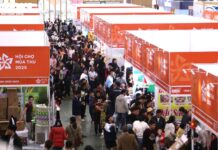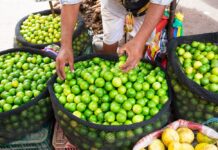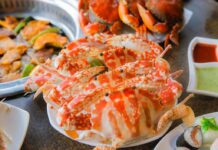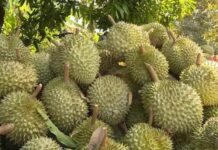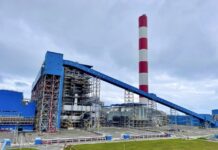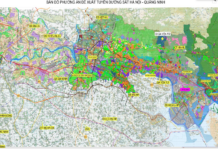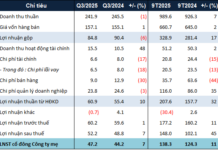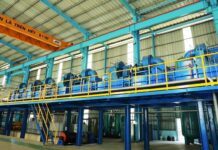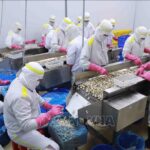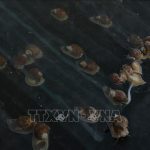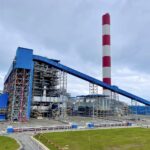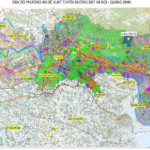Engineer-turned-entrepreneur, Tran Cong Hieu (born 1993, in Nhat Le village, Cam Thuy commune, Cam Lo district, Quang Tri province), faced unemployment when the Covid-19 pandemic hit while he was working on a project in Laos in mid-2019. Unable to bear the stagnation of being confined at home, Hieu sought new opportunities.
Surrounded by rice paddies with low yields, he came across black snail farming through social media. Intrigued, he found that no one in his province was cultivating this species. His curiosity and desire to be a pioneer in local snail farming spurred him to embark on commercial black snail farming.
Despite his family’s initial disapproval out of fear of failure, Hieu persevered and started with a small-scale experiment. He purchased 5kg of snails and set up a 10m2 pond lined with tarpaulin. Unfortunately, the entire batch died shortly after.
Undeterred, he invested 9 million VND in September 2019, buying 30,000 snails and setting up two 15m2 tarpaulin-lined ponds. Despite his meticulous care, the snails grew slowly, and a heavy downpour in October 2019 dealt a devastating blow. Inexperienced in water management, Hieu lost his entire stock as the sudden acid influx from the rainwater drastically reduced the pond’s pH level.
Facing increased opposition from his family, Hieu remained steadfast, borrowing 80 million VND from the Social Policy Bank’s Cam Lo branch through the Farmers’ Association. He was determined to succeed, viewing failures as necessary tuition for future success.
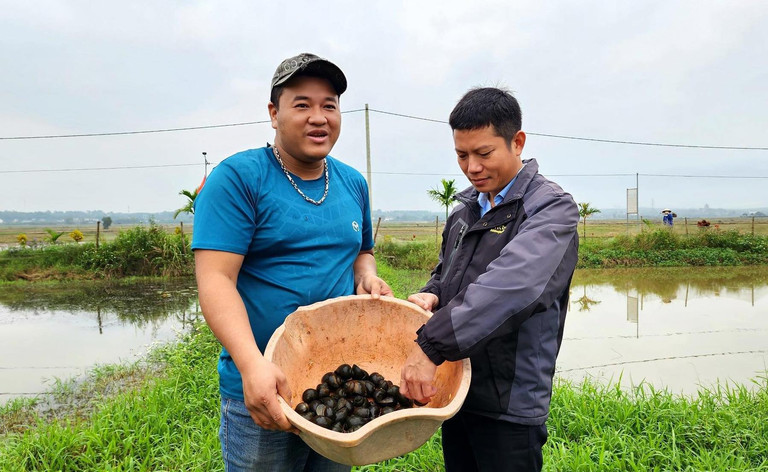
After multiple failures, Tran Cong Hieu (left), from Cam Thuy commune, Cam Lo district, Quang Tri province, successfully mastered black snail farming. Source: Vietnamnet
Learning from his mistakes, Hieu acquired the skill of optimizing water pH between 6.5 and 7 and installed tarpaulin covers to prevent rainwater from flowing into the ponds. He then purchased 10,000 snails, confident that success was within reach. However, after a month, the snails still showed sluggish growth, foreshadowing potential losses.
Recognizing his lack of affinity with the tarpaulin pond method, Hieu decided to take a bold step. With the support of local authorities and access to 1 sào (500m2) of family-owned rice fields, he leased an additional 5 sào of adjacent land to create seven earthen ponds.
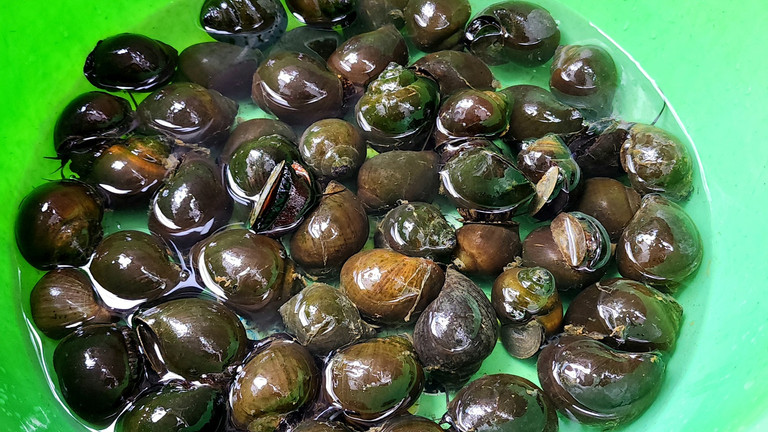
Black snails are fed a diet of vegetables and fruits such as squash, legumes, potatoes, and taro. Source: Vietnamnet
Hieu released all the snails from the tarpaulin ponds into the earthen ones, and they thrived. After three months, he sold 30kg of snails, retaining the rest for breeding. In the following crop, he raised 30,000 snails and was delighted to sell 200kg in April 2020, motivating him to pursue his black snail farming venture.
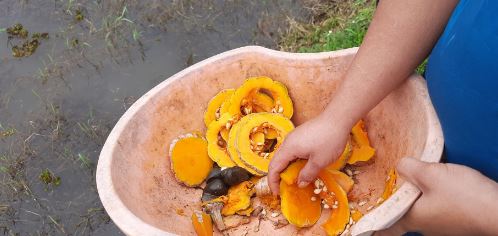
Hieu feeds his black snails a green diet of vegetables and fruits. Source: Ngoc Vu/ Dan Viet
However, his joy was short-lived as a historic flood in October 2020 dealt another blow, wiping out his entire stock. Undeterred, he once again hired excavators to renovate the ponds. His perseverance paid off, and the ponds began to yield good incomes.
From 2021 onwards, he has been selling 2 tons of snails wholesale to provincial buyers annually, earning a profit of 200 million VND after expenses. The demand for his snails now exceeds the supply available for local restaurants.
Sharing his journey with Vietnamnet, Hieu reflected, “As a young entrepreneur with limited experience, I faced consecutive financial blows. However, I view these setbacks as necessary tuition for growth. Despite the sadness, I always sought ways to borrow capital and try again.”
Hieu’s snail farming endeavor has provided him with additional income and allowed him to spend more time with his family, who actively support his farming and harvesting efforts. He plans to produce processed snail products for the market in the future.
When it comes to snail farming expertise, Hieu emphasizes the importance of maintaining a water pH between 6.5 and 7. From April to October, when the weather is warm, snails thrive, and it is the peak season for snail farming. Weekly water changes and the treatment of harmful microorganisms are crucial, as is the addition of grass carp to the ponds, which feed on snail leftovers and aerate the mud, preventing toxic gas buildup.
Black snails are fed a diet of vegetables and fruits, including squash, legumes, potatoes, and taro. Water hyacinth, Egyptian lotus, and water lettuce are grown in the ponds to provide shade in the summer, warmth in the winter, and effective water filtration.
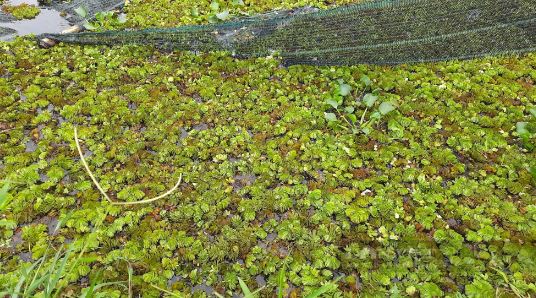
Hieu grows aquatic plants in his snail ponds to provide shade in the summer and warmth in the winter, promoting the snails’ growth and development. Source: Ngoc Vu/ Dan Viet
During the summer, the pond water level should be maintained between 0.8 and 1.2 meters, while in the winter, it should be reduced to 15-20 centimeters. At this lower level, the aquatic plants will settle closer to the pond bottom, providing shelter and warmth for the snails.
After the snails lay their eggs, Hieu transfers them to an incubator with mechanical support, increasing the hatching rate compared to natural conditions. Newly hatched snails require water enrichment with special formulations and soft foods like squash and gourd. Depending on the size requirements of his customers, he raises the snails for 3 to 5 months before selling them.
Mr. Vo Thanh Tu, Vice Chairman of the People’s Committee of Cam Thuy commune, acknowledged the superior economic benefits of Tran Cong Hieu’s black snail farming model compared to traditional rice farming. Hieu’s success has inspired others to follow in his footsteps, contributing to local poverty alleviation efforts.
Tran Cong Hieu’s resilience, determination, and willingness to share his knowledge make him an exemplary model for aspiring entrepreneurs in his community.
Raising profitable sea snails earns over 1 billion VND per year.
After 2 years of transitioning from high-tech shrimp farming to commercial abalone farming, Mr. Dinh Vu Hai (Vinh Trach Dong commune, Bac Lieu City, Bac Lieu province) earns over 1 billion VND annually. Simultaneously, he opens up new opportunities for many farmers in the area who want to switch to a new production model, replacing shrimp due to declining prices and ineffective production.

